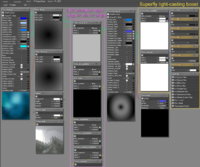Hi,
I was just wondering how many of you prefer to have a MAT set that works in both Firefly and Superfly for products.
Or would you rather have separate MAT files for each render engine?
I find it easier to do one that works in both rather than to do separate ones but since these are retail sets I'd like input.
Thanks.
I was just wondering how many of you prefer to have a MAT set that works in both Firefly and Superfly for products.
Or would you rather have separate MAT files for each render engine?
I find it easier to do one that works in both rather than to do separate ones but since these are retail sets I'd like input.
Thanks.


